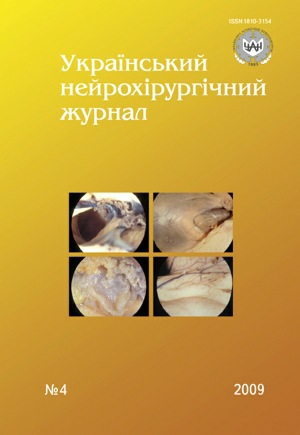Method choice for craniopharyngiomas treatment
DOI:
https://doi.org/10.25305/unj.108008Keywords:
craniopharyngioma, occlusive hydrocephalus, surgical treatment methods, endoscopic third ventriculostomy (ETV), quality of life, Karnofsky ScaleAbstract
Treatment results of 71 patients, operated because of craniopharyngiomas, at whom 95 operations were performed, that has made 1,3 surgical interventions per one patient, were analyzed. Age of patients was from 2 to 63 years. Conducting clinical syndromes depending on age, sizes and an anatomic variant of tumor growth were selected and clinical features of disease were determined. While quality of life estimation according to Karnofsky Scale it was revealed that at punction method application the quality of life after operation increased on 9,6 points, but further decreased on 7 points because of often relapses and necessity of repeated operations performing. At endoscopic method application quality of life after operation increased on 15 points and on 14,1 points more in remote terms. At microsurgical removal of a tumor quality of life after operation increased on 6,7 points and on 10,9 points more — in remote terms. On the basis of obtained data analysis the algorithm for surgical treatment of patients with craniopharyngiomas was developed.
References
Коновалов А.Н., Краснова Т.С., Кадашев Б.А. Микрохирургия краниофарингиом: основные положения и результаты // III Всесоюз. съезд нейрохирургов: Тез. докл. — М., 1982. — С.201–202.
Bunin G.R., Surawicz T.S., Witman P.A. The descriptive epidemiology of craniopharyngioma // J. Neurosurg. — 1998. — V.89. — Р.547–551.
Haupt R., Magnani C., Pavanello M. Epidemiological aspects of craniopharyngioma // J. Pediatr. Endocrinol. Metab. — 2006. — V.19. — Р.289–293.
Karavitaki N., Cudlip S., Adams C.B. Craniopharyngiomas // Endocr Rev. — 2006. — V.27. — Р.371–397.
Karnofsky D.A., Abellmaann W.Y., Craver L.F. The use of the nitrogen mutards in the palliative treatment of carcinoma // Cancer. — 1948. — V.1. — P.634–656.
Kuratsu J., Ushio Y. Epidemiological study of primary intracranial tumours in childhood. A population-based survey inKumamoto// Prefect. Jap. Pediatr. Neurosurg. — 1996. — V.25. — Р.240–246.
Rickert C. H., Paulus W. Lack of chromosomal imbalances in adamantinomatous and papillary craniopharyngiomas // J. Neurol. Neurosurg. Psychiatry. — 2003. — V.74. — Р.260–261.
Downloads
Published
How to Cite
Issue
Section
License
Copyright (c) 2009 G. M. Kariev, N. Kh. Tukhtaev, U. U. Altibaev

This work is licensed under a Creative Commons Attribution 4.0 International License.
Ukrainian Neurosurgical Journal abides by the CREATIVE COMMONS copyright rights and permissions for open access journals.
Authors, who are published in this Journal, agree to the following conditions:
1. The authors reserve the right to authorship of the work and pass the first publication right of this work to the Journal under the terms of Creative Commons Attribution License, which allows others to freely distribute the published research with the obligatory reference to the authors of the original work and the first publication of the work in this Journal.
2. The authors have the right to conclude separate supplement agreements that relate to non-exclusive work distribution in the form of which it has been published by the Journal (for example, to upload the work to the online storage of the Journal or publish it as part of a monograph), provided that the reference to the first publication of the work in this Journal is included.









